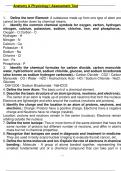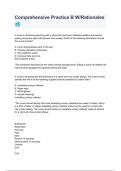Anatomy & Physiology I Assessment Test
1. Define the term Element: A substance made up from one type of atom and
cannot be broken down by chemical means.
2. Identify the common chemical symbols for oxygen, carbon, hydrogen,
nitrogen, calcium, potassium, sodium, chlorine, iron, and phosphorus.:
Oxygen - O Carbon - C
Hydrogen - H
Nitrogen - N
Calcium - Ca
Potassium - K
Sodium - Na
Chlorine - Cl
Iron - Fe
Phosphorus - P
3. Identify the chemical formulas for carbon dioxide, carbon monoxide,
water, hydrochloric acid, sodium chloride, glucose, and sodium bicarbonate
(also known as sodium hydrogen carbonate).: Carbon Dioxide - CO2 / Carbon
Monoxide - CO / Water - H2O / Hydrochloric Acid - HCl / Sodium Chloride - NaCl /
Glucose
- C6H12O6 / Sodium Bicarbonate - NaHCO3
4. Define the term Atom: The basic unit of a chemical element.
5. Describe the basic structure of an atom (protons, neutrons, and electrons).:
The center of an atom is made up of protons and neutrons that form the nucleus.
Electrons are lightweight and orbit around the nucleus (neutrons and protons).
6. Identify the charge and the location in an atom of protons, neutrons, and
electrons.: Charge: Protons have a positive charge, Electrons have a negative
charge and Neutrons have no charge (neutral).
Location: protons and neutrons remain in the center (nucleus). Electrons remain
orbiting outside the nucleus.
7. Define the term Isotope: Two or more forms of the same element that have the
same number of protons but different number of neutrons, and differ in atomic
mass but not in chemical properties.
8. Recognize that isotopes are used in diagnosis and treatment in medicine:
They are used in body scans/nuclear imaging to evaluate thyroid cancer, etc.
9. Define the terms molecule and ion. Explain the role of electrons in chemical
bonding.: Molecule - A group of atoms bonded together, representing the
smallest fundamental unit of a chemical compound that can take part in a
, Anatomy & Physiology I Assessment Test
chemical reaction. Ion - An atom or molecule with a net electric charge due to the
loss or gain of one or more electrons.
Explain role of electrons in chemical bonding - Electrons play a huge role in
chemical bonding. One type is electrovalent bonding (ionic), where an electron from
one atom is transferred to another atom. You end up creating two ions as one atom
loses and electron and another one gains one. BASICALLY, chemical bonding can't
happen without electrons.
10. Compare how covalent and ionic bonds hold atoms together and how
each type of bond is shown in a diagram.: Covalent bonding takes place when
atoms are unstable because their outer ring of electrons aren't filled up. So then
atoms come together and share electrons (forming a molecule). They become
strong and hard to break apart.
Ionic bonding is the complete transfer of valence electrons between atoms. It's a
type of chemical bond that generates two oppositely charged ions. Ionic bonds are
weaker than covalent bonds but still create molecules.
11. Discuss the relative strength of covalent and ionic bonds (how easily the
bonds can be broken).: Covalent bonds are strong and can only be broken by
enzymic catalysis. Ionic bonds are weak and can be broken by temperature and
pressure.
12. Compare polar and nonpolar bonds. Compare and contrast the
characteristics of polar and nonpolar molecules.: Nonpolar covalent bond -
A bond between 2 nonmetal atoms that have the same electronegativity and
therefore have equal sharing of the bonding electron pair.
Polar covalent bond - A bond between 2 nonmetal atoms that have different
electronegativities and therefore have unequal sharing of the bonding electron
pair. Polar Molecules - Have more electrons (+) on one side of the molecule than
the other, resulting in an electrical field in that area.
Nonpolar Molecules - Electrons are distributed more symmetrically and thus does
not have an abundance of charges at the opposite side. The charges all cancel
each other out.
13. Identify the type of bond (polar covalent, nonpolar covalent, or ionic)
found in the following molecules: carbon dioxide, water, hydrochloric acid,
sodium chloride, oxygen gas, and sodium bicarbonate.: Carbon dioxide -
nonpolar (symmetrical)
Water - Polar covalent
Hydrochloric acid - Polar
Sodium Chloride - polar ionic compound (polar)
, Anatomy & Physiology I Assessment Test
Oxygen gas - nonpolar
Sodium bicarbonate - polar
14. Define the term hydrogen bond. Describe the characteristics of hydrogen
bonds.: A weak bond between 2 molecules resulting in an interaction between
an electronegative atom and a hydrogen atom bonded to another electronegative
atom. Hydrogen bonds can occur between molecules or within parts of a single
molecule.
Weaker than covalent and ionic bonds. They only form between oxygen, hydrogen,
nitrogen and fluorine.
15. Identify how hydrogen bonds are shown in a diagram.:
https://www.wyzant.com/resources/lessons/science/chemistry/bonds
16. Define the terms matter and mass: Matter - Physical substance in general,
what occupies space and has mass, especially as distinct from energy. Mass - a
coherent, typically large body of matter with no definite shape.
17. Identify and describe the properties of the 3 states of matter: Liquid -
Assumes the shape of the container it occupies, particles slide past each other,
little free space between, not easily compressible, flows easily.
Solid - retains fixed volume, particles locked in place, does not flow easily.
Gas - Assumes shape and volume of container, easily compressible, flows easily,
particles move past each other.
18. Compare and contrast the random motion of particles in a liquid, solid,
and gas and the effect of temperature on the motion.: Liquid - particles slide
past each other, temperature turns liquid to vapor (gas) or solid.
Solid - particles are locked in place, temperature turns solid to liquid.
Gas - particles move past each other quickly,
19. Describe the relationship between temperature, pressure, and volume in
a closed system. (You do NOT need to know the formulas, just the
relationships.): Boyle's Law - Remember that gas responds to pressure
changes by changing their volume. Volume and pressure change in a closed
environment if temperature changes and the number of molecules increases or
decreses (both mentioned have to remain the same). P1V1=P2V2
20. Describe the polarity of water: The net result of the overall negative charge
of the oxygen atom and the overall positive charge of the two hydrogen atoms. A
water molecule is polar because the oxygen atom at the top of the molecule has
a more negative charge, while the bottom of the molecule has a more positive
charge.





